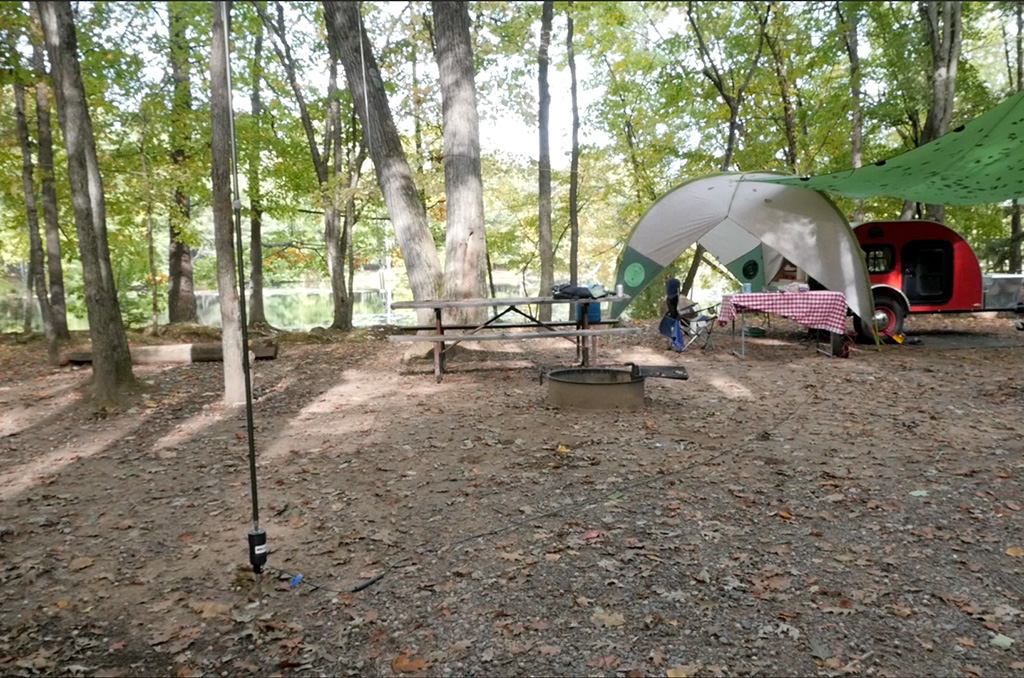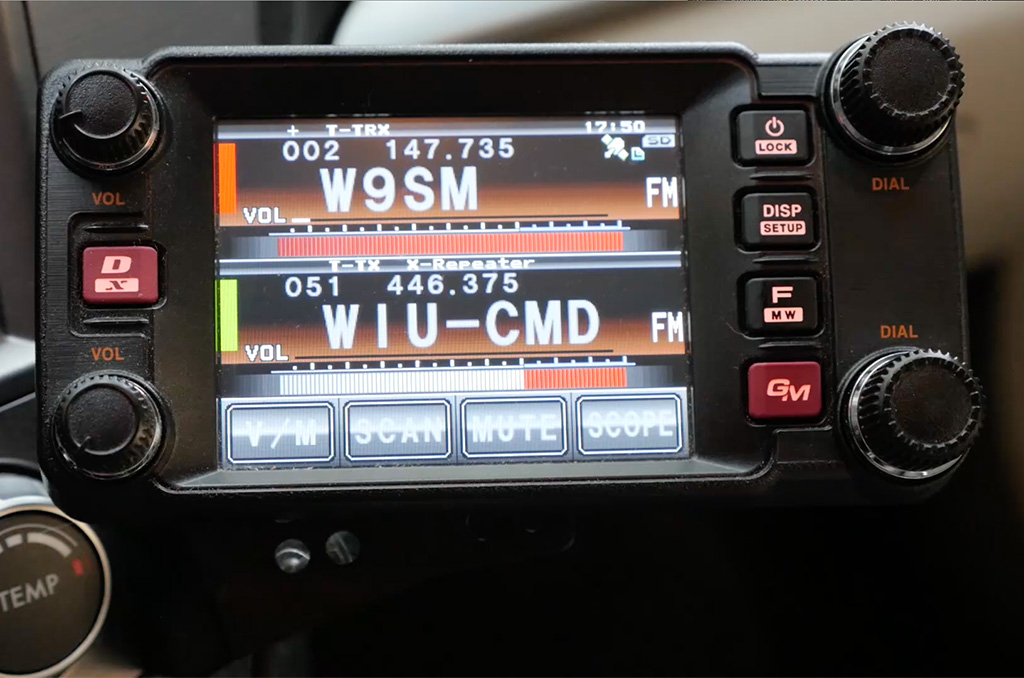September was a busy month- I did manage to get outside with some field operations and attended a rained out Radioexpo last week. I appreciate and thank the Chicago FM Club for the hard work they put into that show every year. Hopefully next year will have better weather. But in Wisconsin we’re full-on with autumn now. As long as the weather holds out‚ I’ll get a couple more field videos out. Stay tuned to the end of the video for more news and coming attractions. In the meantime, we’ll answer some questions that came up in the last month.
My video comparing the Chameleon MPAS and Wolf River Coil generated a really good conversation. Generally I’m glad to hear there are fans of both antenna systems and that both styles are working well for their field operations. It was never my intention to say one was better than the other as they are unique enough to provide their own advantages. But starting out Glenn asks:
Good comparison, appreciate the work… What other whips will fit the Wolfriver coil ?? ??? Thanks , KD9NIT Glenn
The Wolf River coil has a 3/8 x 24 nut on it‚ so any whip with a matching stud could be used. The MPAS uses the same 3/8×24 lug so you could mix and match between the two systems if you so desired. Or if you wanted to create a super lightweight system‚ you could put a ring terminal on a piece of wire and suspend the wire in a tree.
 Speaking of alternate installations‚ Carl of Chameleon Antennas says:
Speaking of alternate installations‚ Carl of Chameleon Antennas says:
The MPAS 2.0 comes with a 25′ and a 73′ long wire which can be used for radiator or counterpoise. So if you really want to tune the unit just with the counterpoise then use the 73′ and roll or unroll the counterpoise until you obtain the lowest SWR. If you do so, you won’t need the tuner.
Also remember that if you’re using a SINGLE counterpoise then the MPAS will have more gain toward the direction the counterpoise is pointing.
If you’ve trees in your area and you want to maximize the antenna performance, then you’ll use the 73′ long wire as radiator and 25′ long as counterpoise and set the 73′ in a sloper configuration and extend the counterpoise at the opposite side of the 73′ long radiator. That will allow the unit to cover everything from 6M to 160M with a tuner.
Thanks for the clarifications and I’ll continue to do more activities with the MPAS- trying out additional radials and a counterpoise for enhance operation. The MPAS is really versatile- there’s another youtube reviewer that calls it the Lego system of antennas. I’m planning another video this fall with some of those alternate installations and show you way‚ as Carl mentioned‚ to deploy it in the field without the use of a tuner. As I dig more and more into the MPAS 2.0 I become increasingly impressed with its versatility and how individual components can be utilized in different ways to provide a field communication solution for a particular situation.
 Not that the Wolf River Coil by not means is a perfect antenna‚ Don mentions a downfall of it:
Not that the Wolf River Coil by not means is a perfect antenna‚ Don mentions a downfall of it:
Any discussion of loading coils should point out the less than desirable RF resistance of stainless steel. When trying to make a shortened antenna more efficient, the last thing you need to do is add several more ohms at the worst possible point – the coil. Oh but it looks shiny – I guess that’s good enough.
Despite the bit of snark at the end you bring up a good point. There is a tradeoff between efficiency and durability. But the resistance in the coil is real and can cause inefficiencies and heat especially at the lower bands. Wolf River does recommend limiting the power to 100 watts CW and 25 watts for the digital modes. So I guess you need to decided if the added resistance of stainless steel really is that much of a concern and if negates the other advantages of the antenna. As an antenna manufacturer myself I know that we need to make decisions on building materials and construction methods. and durability often wins out over perfect efficiency. Both Wolf River and Chameleon understand this and they create quality products using materials that will provide a long life for the antenna. Which brings me to Marvin’s comment
I have the Chameleon antenna system, including their EmComm wire antenna for 10-80. I’ve found the wire more efficient than the whip, which is not surprising. The inverted L or inverted V and Sloper set up’s work especially well when the counterpoise is well oriented in a direction of special interest. I’ve wanted to have a silver bullet in spite of the more complex set up requirements. Obviously you proved the point that a resonate antenna is superior to a non-resonate antenna as a general principle. Every time we make a compromise something is lost so taking that into account is also important when considering if these antenna’s are suitable for the operating objectives of HAM’s who wish to have a portable quickly deployed multi-band antenna. I don’t think there is a one size that fits all when it comes to meeting such objectives.
There is no perfect antenna or antenna system. Everything is a compromise be it space‚ location‚ mobility‚ or power. Pick the antenna that works best for your objectives and fits within your limitations.
 Moving on- I received a few excellent comments and questions on my video about Cross Band repeating. Starting off‚ K8MH says:
Moving on- I received a few excellent comments and questions on my video about Cross Band repeating. Starting off‚ K8MH says:
Nice informational video. Can you crossband with digital C4FM also?
No you can’t- the Yaesu FTM-400 will cross band analog only. In the cross band mode the audio is routed through the system in such a way that it bypasses the C4FM vocoder. Plus the FTM-400 only has one vocoder so it can’t do a digital to digital cross band.
There was a bit of discussion concerning identification during Cross Banding. I talked about that requirement in the video but still had to do a bit of clarification in the comments. Stan mentions:
You have to make sure that your crossband radio is capable to identify itself every 10 minutes.
The issue is a little more complex than this‚ and I touch on this very problem of cross banding in the video. The VHF side is good as it is identified when you identify in the normal course of a transmission. The UHF side that comes back to your handheld is the one that would be considered an unidentified transmission. Yes there may be an identification tied to it via the repeater or another station using the repeater. But since the UHF transmission is originating from your radio‚ it also needs your callsign attached to it. Remember you are using two transmitters‚ your handheld and the cross band transceiver and that second transceiver- with the signal emitting from it needs some form of identification
How to solve this issue? Kenwood TM-V71A and TM-D710G both have auto identifiers built it- so if cross banding is an essential feature to your activities I’d recommend those radios. You could have the other party on the repeater identify on your behalf eg: K9XYZ on KB9VBR cross band‚ But this is cumbersome and the other person may not realize you are cross banding. Or third‚ do a identification on the UHF channel from the cross band radio when you turn the cross band off. It’s better than nothing but doesn’t satisfy the 10 minute rule.
That being said‚ you can see why people cross band‚ don’t identify the UHF channel‚ and hope all will be well.
Moving on- My video on if you should upgrade your license to General still receives comments. Indrid says
Do not upgrade. The amateur HF equipment is extremely expensive and there is almost no surplus equipment that can be converted to amateur HF. VHF and UHF equipment is very affordable and old surplus equipment is very easy to convert to amateur radio bands. HF is very expensive.
Two points I want to make here. I don’t believe that the cost of HF equipment should be a reason why you shouldn’t upgrade. I know of many General and Extra license holds for that matter that seldom‚ if ever‚ get on the HF bands. Second- I hear this complaint often about the cost of HF equipment. Personally I believe the price of HF equipment is more affordable than ever. Miniaturization of components and assembly line automation has made electronics extremely affordable. Granted amateur radio equipment is a niche item so it will be more expensive than a general consumer good- but an entry level HF transceiver like the Yaesu FT-450 or Icom IC-718 are comparatively cheap considering inflation and what you could buy 25 or 30 years ago. But this brings to light a bigger issue in our economy.
Wage inequality and stagnation are real things and it is affecting the middle class at a higher rate than ever before. Interest rates are seemingly low and the economy is going full tilt‚ but wages have not kept up with the cost of food‚ housing‚ and durable goods. These are big issues that need to be addressed on a national level and I am not going to delve into a political discussion of that. But I will say that our dollar continues to buy less and we also have less dollars in our pocket. So that means used equipment holds its value well and new equipment could be just out of reach of a new ham.
I’ll get down from my soapbox now and talk about some things coming this month.
Christian‚ K0STH‚ of 100 Watts and a Wire wanted me to mention the upcoming Fall Out event on October 11-13. Mobile‚ portable‚ or just from the comfort of your own shack- exercise your gear and get on the air. Any Band any mode any time. Did I mention there are prizes. So get your 100watt ID number and get on the air next weekend. Details for the event can be found at 100wattsandawire.com A link is in the video description below.
Next up I’ve had some requests for a more complete video on digital and using the Winlink system for email. So look for a start to finish video on setting up a digital station and going out into the field to send and receive some email with Winlink. It should be fun. I also had a great conversation at RadioExpo with John Kruk of Yaesu about their new FT3DR handheld radio- so look for that also. If there is a topic you’d like to see leave me a comment and I’ll add it to the list.
That’s it for this month’s questions, please keep them coming. Leave them as a comment below, I’ll filter through them and keep the conversation going. Maybe one will even show up on the next your questions answered video.
Recent Comments